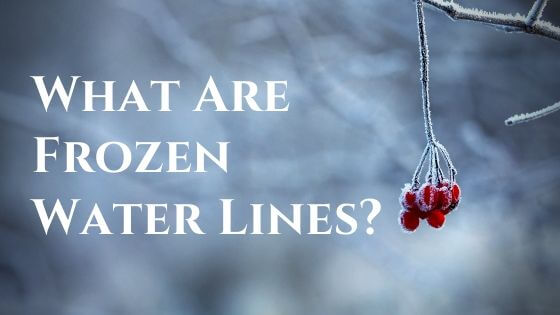Water pipes can freeze during the cold days in winter. Drafts and poor heating or insulation can start to freeze pipes in your home. When the outside gets colder, the frost travels deeper, putting water pipes at risk of freezing.
Frozen pipes are a problem for two reasons. They can create an inconvenience and also can cause major damage to your home. Water expands as it freezes, putting tremendous pressure on the pipes. Without proper precautions to protect your pipes from freezing, you may be left without water for long periods.
The Signs Of Frozen Water Lines
One of the quickest ways of detecting a frozen pipe is to check if no water comes out of your faucet when you turn it on. If you notice that, go to the basement and check to see that the water is still turned on and that you don’t have a leak. When you confirm these two steps, continue your inspection to make sure one of your pipes has not raptured.
If your search reveals that your pipes got frozen but none have ruptured, you have two choices:
- Attempt to thaw the frozen pipes yourself: While you can thaw frozen pipes yourself, you should keep the safety of your house in mind. You should never use an open flame, such as a propane torch. This will damage the pipe, and may also start a fire in your property.
- Call a plumber to help thaw your frozen pipes: It is a good idea to call help if you think that you cant thaw the pipes by yourself. If you don’t know where the frozen pipes are or you can’t access the frozen area, you should call an expert
How To Thaw Frozen Pipes Yourself
Here are the steps you can take to thaw the pipes:
- Keep your faucet open. Your pipes need an opening to discharge water and stream. You need to keep the faucet open to let the moving water to run through the pipe. This will make the thawing process easy.
- Apply heat to the part of the pipe that frozen. You can wrap an electronic heating pad around the pipe or heat the area with a hairdryer. If you don’t have any of these items, then you can use a towel soaked in hot water. It will help as well.
- Do NOT use an open flame. Don’t use a blowtorch. Moreover, you should not use a space heater unless you are sure the area is clear of any flammable material.
- Keep on the heat until water flow returns to normal. Once you have thawed the pipe, turn on other faucets in your home to check if there are any other frozen water pipes. If you cannot find the frozen area, or if the frozen area is inaccessible, call a licensed plumber.
Preventing Frozen Pipes
There are steps you can take to help prevent your pipes from freezing in the future and prevent damage. This includes:
- Allow the faucets and taps to drip slowly.
- Shut off, disconnect, and drain all outdoor hoses and faucets.
- Keep the kitchen and bathroom cabinet doors open.
- Insulate the attics, basements and crawl spaces to maintain higher temperatures in these areas.
Conclusion
Frozen water pipes and the damage they can do affect thousands of houses each year. That especially happens when you are at below freezing temperature for a long time.
Plumbing 911 is a family-owned and operated company servicing Medina, Stark, Portage, Summit, Cuyahoga, and Lake counties. If you need to thaw any frozen pipes, or fix a pipe that has burst, our expert technicians will be able to remedy the problem for you.













